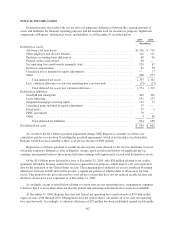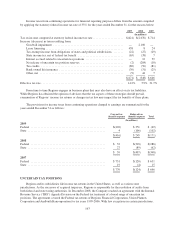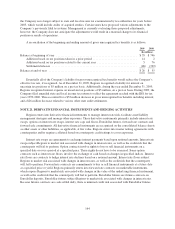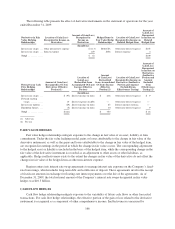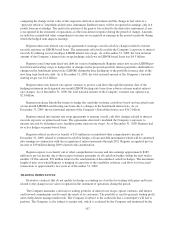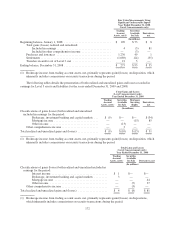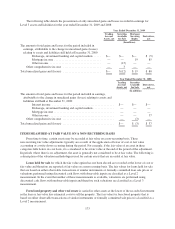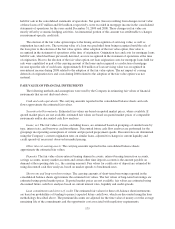Regions Bank 2009 Annual Report Download - page 184
Download and view the complete annual report
Please find page 184 of the 2009 Regions Bank annual report below. You can navigate through the pages in the report by either clicking on the pages listed below, or by using the keyword search tool below to find specific information within the annual report.unobservable assumptions reflect the Company’s own estimates for assumptions that market
participants would use in pricing the asset or liability. Valuation techniques typically include option
pricing models, discounted cash flow models and similar techniques, but may also include the use of
market prices of assets or liabilities that are not directly comparable to the subject asset or liability.
ITEMS MEASURED AT FAIR VALUE ON A RECURRING BASIS
Trading account assets, securities available for sale, mortgage loans held for sale, and derivatives were
recorded at fair value on a recurring basis during 2009 and 2008. Mortgage servicing rights were recorded at fair
value on a recurring basis during 2009 and at lower of aggregate cost or estimated fair value during 2008. Below
is a description of valuation methodologies for these assets and liabilities.
Trading account assets, net and securities available for sale primarily consist of U.S. Treasuries,
mortgage-backed and asset-backed securities (including agency securities), municipal bonds and equity securities
(primarily common stock and mutual funds). Regions uses quoted market prices of identical assets on active
exchanges, or Level 1 measurements. Where such quoted market prices are not available, Regions typically
employs quoted market prices of similar instruments (including matrix pricing) and/or discounted cash flows to
estimate a value of these securities, or Level 2 measurements. Level 2 discounted cash flow analyses are
typically based on market interest rates, prepayment speeds and/or option adjusted spreads. Level 3
measurements include discounted cash flow analyses based on assumptions that are not readily observable in the
market place. Such assumptions include projections of future cash flows, including loss assumptions, and
discount rates. Trading assets are presented net of short-sale liabilities which are valued based on the fair value of
the underlying securities.
Mortgage loans held for sale consist of residential first mortgage loans held for sale that are valued based
on traded market prices of similar assets where available and/or discounted cash flows at market interest rates,
adjusted for securitization activities that include servicing value and market conditions, a Level 2 measurement.
Regions has elected to measure mortgage loans held for sale at fair value by applying the fair value option (see
additional discussion under the “Fair Value Option” section below).
Mortgage servicing rights consist of residential mortgage servicing rights and were valued during 2009
using an option-adjusted spread valuation approach. During 2008, mortgage servicing rights were valued by
projecting and discounting future cash flows. Various assumptions including future cash flows, market discount
rates, expected prepayment rates, servicing costs and other factors are used in the valuation of mortgage servicing
rights, and therefore are Level 3 measurements. As discussed in Note 1, on January 1, 2009, the Company made
an election to prospectively change the policy of accounting for mortgage servicing rights under the fair value
method. Prior to this date, mortgage servicing rights were accounted for under the amortization method and
adjusted to the lower of aggregate cost or estimated fair value as appropriate.
Derivatives, net which primarily consist of interest rate contracts that include futures, options and swaps,
are included in other assets and other liabilities (as applicable) on the consolidated balance sheets, and are
presented in the tables below as a net amount. For exchange-traded options and futures contracts, values are
based on quoted market prices, or Level 1 measurements. For all other options and futures contracts traded in
over-the-counter markets, values are determined using discounted cash flow analyses and option pricing models
based on market rates and volatilities, or Level 2 measurements. Interest rate lock commitments on loans
intended for sale, treasury locks and credit derivatives are valued using option pricing models that incorporate
significant unobservable inputs, and therefore are Level 3 measurements.
Interest rate swaps are predominantly traded in over-the-counter markets and, as such, values are determined
using widely accepted discounted cash flow models, or Level 2 measurements. These discounted cash flow
models use projections of future cash payments/receipts that are discounted at mid-market rates. These valuations
are adjusted for the unsecured credit risk at the reporting date, which considers collateral posted and the impact
of master netting agreements.
170




